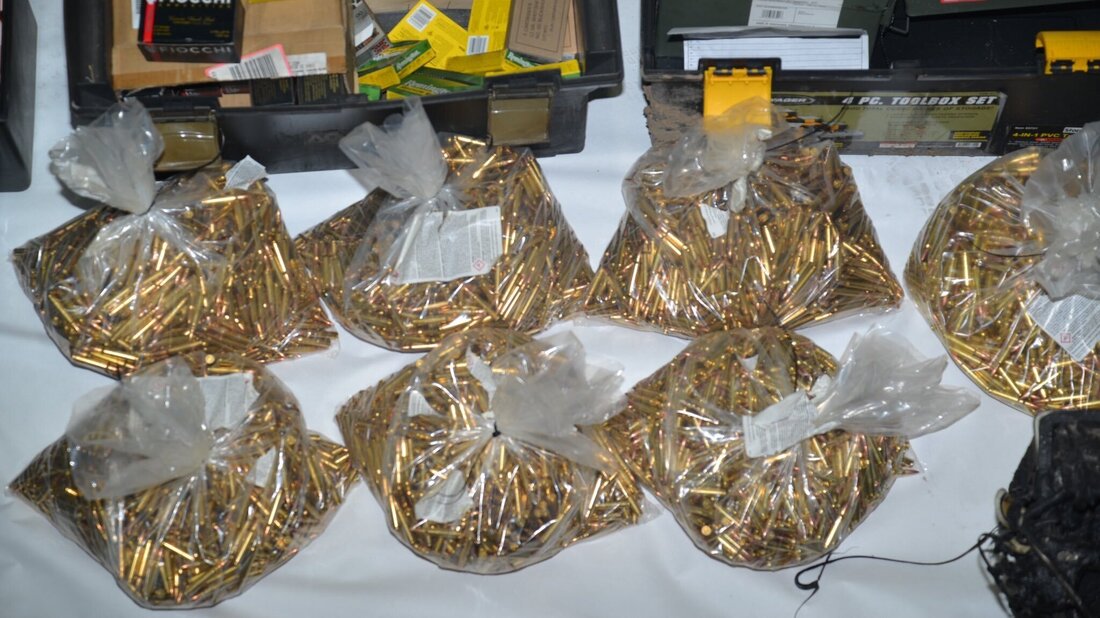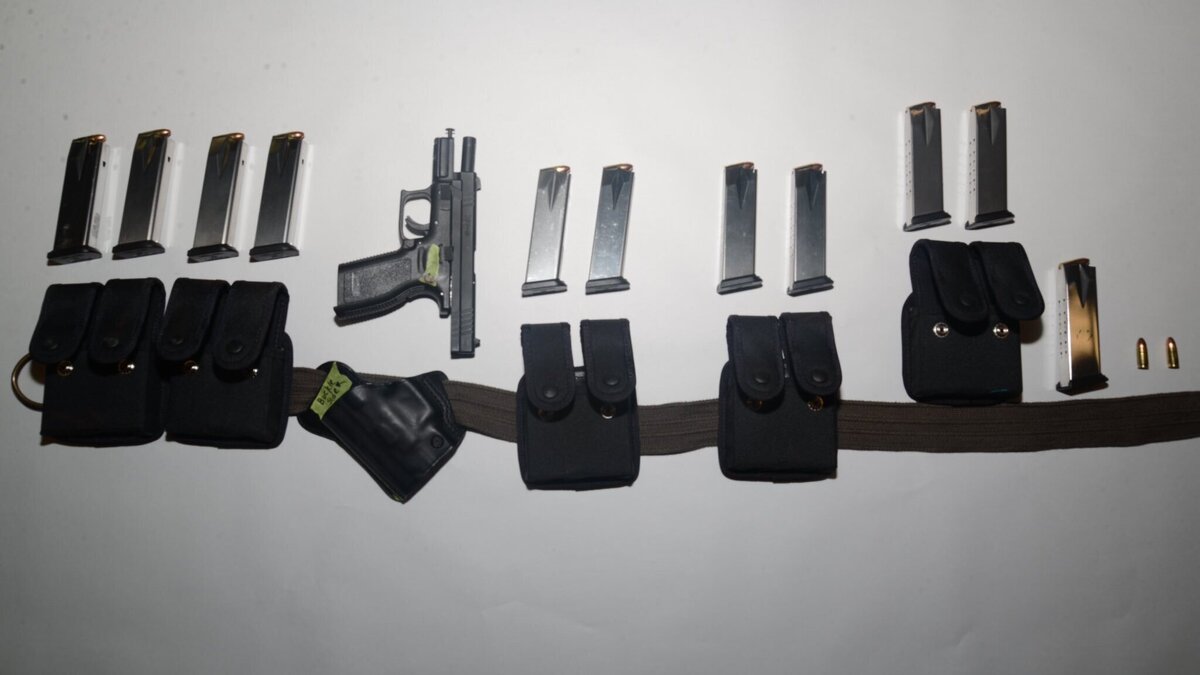[ad_1]

The Santa Clara County Sheriff’s Office shows approximately 22,000 thousand rounds of ammunition found at the residence of Samuel Cassidy, the suspect in Wednesday’s shootings at a San Jose, Calif., rail station.
Santa Clara County Sheriff’s Office via AP
hide caption
toggle caption
Santa Clara County Sheriff’s Office via AP

The Santa Clara County Sheriff’s Office shows approximately 22,000 thousand rounds of ammunition found at the residence of Samuel Cassidy, the suspect in Wednesday’s shootings at a San Jose, Calif., rail station.
Santa Clara County Sheriff’s Office via AP
SAN FRANCISCO — The gunman who killed nine of his co-workers at a California rail yard had stockpiled weapons and 25,000 rounds of ammunition at his house before setting it on fire to coincide with the bloodshed at the workplace he seethed about for years, authorities said Friday.
Investigators found 12 guns, multiple cans of gasoline and suspected Molotov cocktails at Samuel James Cassidy’s house, the Santa Clara County sheriff’s office said in a news release.
The cache at the home the 57-year-old torched with a slow-burn device was on top of the three 9 mm handguns he brought Wednesday to the Santa Clara Valley Transportation Authority in San Jose, authorities said. He also had 32 high-capacity magazines, some with 12 rounds, and fired 39 shots.

Authorities found 12 guns and more than 20,000 rounds of ammunition at Cassidy’s home, which he had set on fire before the shootings.
Santa Clara County Sheriff’s Office via AP
hide caption
toggle caption
Santa Clara County Sheriff’s Office via AP

Authorities found 12 guns and more than 20,000 rounds of ammunition at Cassidy’s home, which he had set on fire before the shootings.
Santa Clara County Sheriff’s Office via AP
The guns he used to kill his co-workers appear to be legal, officials said. They have not said how he obtained them. Officials did not specify what type of guns they found at his home.
The house was so cluttered with flammable materials that it slowed the investigation, San Jose police Officer Steve Aponte said. Crews finished combing through it Friday to make sure it was safe before opening the cul-de-sac back to neighbors. A suspicious package that investigators found in the attic turned out to be harmless inert batteries and wiring, he said.
Cassidy killed himself as sheriff’s deputies rushed into the transit rail yard in the heart of Silicon Valley, where he shot and killed nine men ranging in age from 29 to 63.
What set off Cassidy was still being investigated, Aponte said.
While witnesses and Santa Clara County Sheriff Laurie Smith have said Cassidy appeared to target certain people, the sheriff’s office said Friday that “it is clear that this was a planned event and the suspect was prepared to use his firearms to take as many lives as he possibly could.”
Taptejdeep Singh, the 36-year-old father of a 3-year-old son and a 1-year-old daughter, was on an early shift as a light rail operator when the shooting began. He called another transit employee to warn him, saying he needed to get out or hide.
“From what I’ve heard, he spent the last moments of his life making sure that others — in the building and elsewhere — would be able to stay safe,” co-worker Sukhvir Singh, who is not related to Taptejdeep Singh, said in a statement.
Singh’s brother-in-law, P.J. Bath, said he was told Singh was killed after encountering the gunman in a stairwell.
“He just happened to be in the way, I guess,” Bath said.
Kirk Bertolet, 64, was just starting his shift when shots rang out, then he heard the screams. He and his co-workers threw a table in front of their door, and Bertolet called the control center.
Then there was silence.
Cautiously, Bertolet left the barricaded office, hoping he could offer first aid. He couldn’t. He saw some of his co-workers take their last breaths.
Bertolet, a signal maintenance worker who worked in a separate unit from Cassidy, said he is convinced Cassidy targeted his victims, because he didn’t hurt some people he encountered.
“He was pissed off at certain people. He was angry, and he took his vengeance out on very specific people. He shot people. He let others live,” he said.
Glenn Hendricks, chairman of the transit authority’s board of directors, said he had no information about any tensions between Cassidy and the co-workers he shot.
Video footage showed Cassidy calmly walking from one building to another with a duffel bag filled with guns and ammunition to complete the slaughter, authorities said.
Cassidy’s ex-wife said he had talked about killing people at work more than a decade ago. Cecilia Nelms told The Associated Press that he used to come home from work resentful and angry over what he perceived as unfair assignments.
He also spoke of hating his workplace when customs officers detained him after a 2016 trip to the Philippines, a Biden administration official told the AP.
A Department of Homeland Security memo said Cassidy also had notes on how he hated the Valley Transportation Authority, according to the official. The official saw the memo and detailed its contents to the AP but was not authorized to speak publicly about the ongoing investigation.
The Wall Street Journal first reported the memo.
It doesn’t say why he was stopped by customs officers. It said he had books about “terrorism and fear and manifestos” but when he was asked whether he had issues with people at work, he said no. The memo notes that Cassidy had a “minor criminal history,” citing a 1983 arrest in San Jose and charges of “misdemeanor obstruction/resisting a peace officer.”
San Jose police said in a statement through Mayor Sam Liccardo’s office that they sought an FBI history on Cassidy and found no record of federal arrests or convictions.
“Whatever this detention at the border was, it did not result in an arrest that showed up on his FBI criminal history, and it was not reported to SJPD,” the statement said.
Neighbors, acquaintances and an ex-girlfriend described him as a loner, unfriendly and prone at times to fits of anger.
Cassidy was hired in 2001, according to the transit authority. Bertolet said Cassidy worked regularly with the victims but he always seemed to be an outsider and perhaps couldn’t take the rough humor of colleagues.
“He was never in the group. He was never accepted by anybody there. He was always that guy that was never partaking in anything that the people were doing,” Bertolet said.
___
Dazio reported from Los Angeles.
[ad_2]
Source link